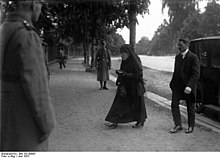Mathilde Rathenau
Sabine Mathilde Rathenau (born March 17, 1845 in Mainz ; † July 28, 1926 Schloss Freienwalde / Bad Freienwalde (Oder) ) was the wife of the AEG founder Emil Rathenau and mother of the later Foreign Minister Walther Rathenau .
Life
Mathilde Rathenau came from the old Jewish merchant and banker family Nachmann, whose family tree goes back to the Talmudic scholar and Kabbalist Mose Ben Nachman (1194–1270). Her father, the banker Isaak Nachmann (1816–1870), moved with the family to Frankfurt am Main in 1855 , not least to give Mathilde an adequate schooling. In 1866 she married the Berlin industrialist Emil Rathenau (1838-1915), with whom she had the children Walther (1867-1922), Erich (1871-1903) and Edith (1883-1952). Mathilde had a particularly close relationship with Walther and gave him an interest in art and science.
On the occasion of their silver wedding anniversary , the Rathenau couple founded the “Mathilde Rathenau Foundation for female relatives and survivors of employees of the AEG and Berliner Elektrizitätswerke” in 1892. This foundation should guarantee all female employees, all wives of employees and their children free medical treatment in the event of illness. The foundation also financed stays for the employees' children in holiday camps and ran a pension and support fund.
Mathilde Rathenau was hit hard by the murder of her son Walther in 1922. She played an important role in the commemorations because, according to the historian Manuela Achilles, from the republican perspective she embodied on the one hand the deeply injured republic, on the other hand also forgiveness and reconciliation. A frequently quoted letter, which Mathilde Rathenau wrote to the mother of Ernst Werner Techow , who was accused of murder, on the occasion of the criminal trial against the conspirators contributed to this :
“In nameless pain I hold out my hand to you, poorest of all women. Tell your son that, in the name and spirit of the murdered man, I forgive him, as God may forgive him if he makes a full open confession before earthly justice and repents before divine justice. If he had known my son, the noblest person on earth, he would rather have turned the murder weapon on himself than on him. May these words bring peace to your soul. "
In the last years of her life, Mathilde Rathenau tried to get the public memory of her son Walther. She put his estate in order and, in December 1922, won over Harry Graf Kessler to write her first official biography after first thinking of Stefan Zweig. In June 1923 she handed over the villa on Koenigsallee in Berlin-Grunewald to the state for a museum and as the seat of the newly established Walther Rathenau Foundation. After her death at Walther Rathenau's summer residence at Schloss Freienwalde, her heiresses gave away the castle and foundation shares to the Oberbarnim district . She found her final resting place in the family grave of the Rathenau family on the state's own forest cemetery Oberschöneweide in field I / 1.
Honors
Mathildenstrasse in Berlin-Oberschöneweide is named after Mathilde Rathenau. BVV Treptow-Köpenick's proposal to name a new Spree bridge after it was rejected in 2016. In February 2019, another bridge was named after her: On the Mathilde-Rathenau-Brücke in Berlin-Plänterwald , Kiefholzstrasse leads over the new construction section of the A 100 motorway .
literature
- Thomas Irmer: Sabine Mathilde Rathenau b. Nachmann . In: District Office Treptow-Köpenick of Berlin (ed.): Women's mosaic. New women's biographies from the Berlin district of Treptow-Köpenick . Trafo Verlag, Berlin 2009, ISBN 978-3-89626-862-4 , pp. 13–32.
- Thomas Irmer: A factory foundation for women. On the history of the “Mathilde Rathenau Foundation” for female employees of the Allgemeine Elektricitäts-Gesellschaft (AEG) in the German Empire . In: Andreas Ludwig, Kurt Schilde (ed.): Jewish welfare foundations. Initiatives by Jewish founders between charity and social reform . Fachhochschulverlag, Frankfurt am Main 2010, ISBN 978-3-940087-66-9 , pp. 213-237.
- State capital Mainz, women's office (ed.): Women's life in Magenza. The portraits of Jewish women from the Mainz women's calendar and texts on women's history in Jewish Mainz . 3rd edition, Mainz 2010, p. 17.
Web links
Individual evidence
- ↑ Manuela Achilles: Reforming the Reich. Democratic Symbols and Rituals in the Weimar Republic. In: Kathleen Canning et al. (Ed.): Weimar Publics / Weimar Subjects. Rethinking the Political Culture of Germany in the 1920s . Berghahn Books, NY 2010, p. 184 f.
- ↑ Volker Ullrich: Five shots on Bismarck. Historical reports. CH Beck, 2nd edition, Munich 2003, p. 159.
- ↑ Harry Graf Kessler, Walther Rathenau. His life and work. With an afterword by Cornelia Blasberg. Frankfurt a. M. Fischer Taschenbuch, 1988. p. 353 and note 3.
- ^ Sabine Flatau: The bridge is to be named after Mathilde Rathenau. In: www.morgenpost.de. Accessed June 8, 2016 (German). Berlin House of Representatives: Drucksache 17/18728 Written question 17th electoral period Written question from MP Carsten Schatz (LINKE) from 14. June 2016 and answer. Senate Department for Urban Development and the Environment, Berlin, June 30, 2016, accessed on July 14, 2016 (German).
- ↑ Ralf Drescher: Passed the Mathilde-Rathenau-Brücke over the A 100. Published on www.berliner-woche.de on March 1, 2019
| personal data | |
|---|---|
| SURNAME | Rathenau, Mathilde |
| ALTERNATIVE NAMES | Rathenau, Sabine Mathilde; Nachmann, Sabine Mathilde |
| BRIEF DESCRIPTION | Wife of the AEG founder Emil Rathenau |
| DATE OF BIRTH | March 17, 1845 |
| PLACE OF BIRTH | Mainz |
| DATE OF DEATH | July 28, 1926 |
| Place of death | Bad Freienwalde (Oder) |



